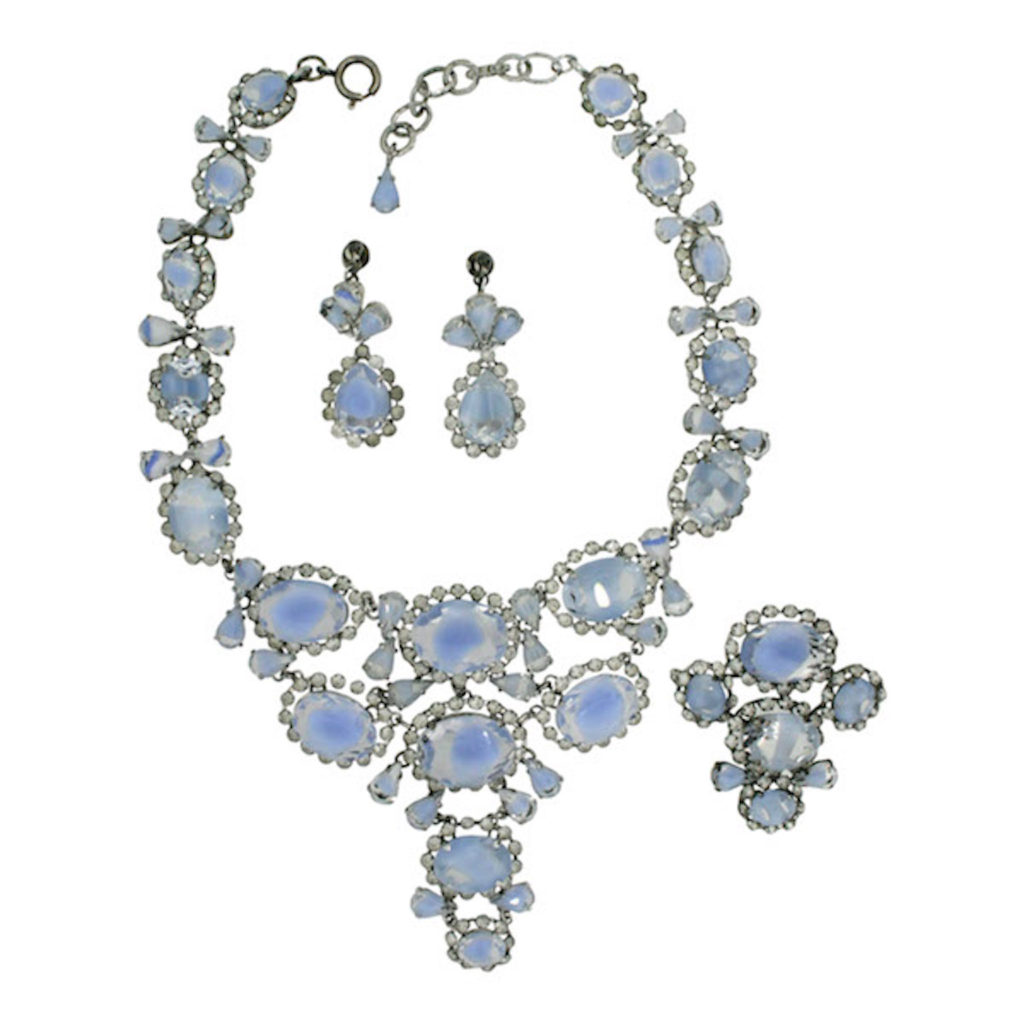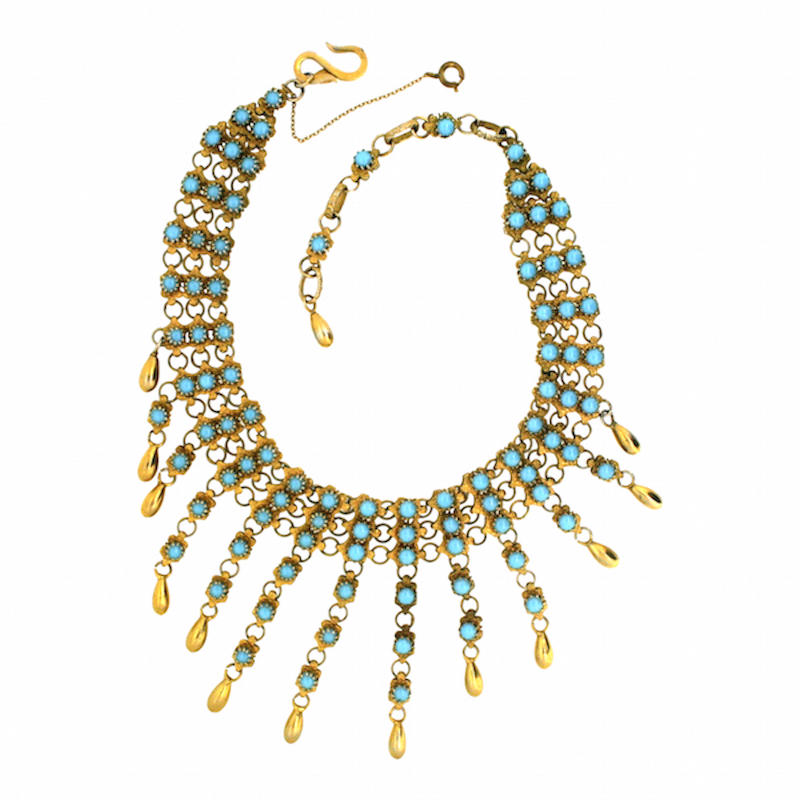How to collect Christian Dior costume jewellery
Vintage costume jewellery specialist Gemma Redmond explores the Christian Dior – Designer of Dreams exhibition in Paris and offers advice on collecting jewellery by the French design legend.
The ‘Christian Dior – Designer of Dreams’ exhibition opened at the Paris Musée des Arts Décoratifs in July. Celebrating 70 years of the French fashion house, it is the largest Dior retrospective ever staged and is certainly set to become renowned as one of the most lavish, featuring astrological light projections, ceilings of delicate paper flowers and multi-storey glass display cases.
For the antiques and vintage enthusiast, an excellent way to understand the design flare and craftsmanship of Christian Dior, is through the glorious multitude of costume jewellery the company has produced during its seven decades. Here’s some essential advice for readers who want to begin collecting Dior costume jewellery.
A Design Team
In addition to being a remarkable designer, Christian Dior was also a highly skilled
business man. He understood that he was surrounded by talented costume jewellery
manufacturers in Paris and abroad, so enlisted only the very best of these to produce for his brand. These companies and designers were known as ‘paruriers’ – makers of accessories to compliment the couture collections. Some of the key paruriers to look out for that created for Dior are:
Henkel and Grossé

In 1955 the German company was selected to produce jewellery for Dior and this
relationship with the Pforzheim manufacturer continues through to this day. Henkel and Grossé specialised in gold coloured metal pieces, but for Dior they went on to produce highly elaborate rhinestone sets of jewellery too.
Mitchel Maer
An American based in England, Maer produced jewellery for Dior between 1952 and 1956. His creations were very technically advanced and were often inspired by a Victorian aesthetic.
Roger Scemama
Scemema was one of the most famed paruriers of his generation. In the 1950s, he worked with Christian Dior. Scemama’s designs for the house were opulent and baroque. Indeed, his work met well with the post-war return to feminine and romantic fashions.
Francis Winter

Winter was the darling of the mid-century fashion magazines with his highly romantic creations. He favoured the use of large scale Swarovski carved stones in wondrous shades, such as ‘Heliotrope’ and ‘Bermuda Blue’.
Roger Jean Pierre
Jean Pierre achieved the Neiman Marcus ‘Oscar of Fashion’ award in 1962 for his work with couturiers. He was a great advocate of garlands and graduation in his pieces, which worked with the movement of the body.
Where to Buy?
Certain examples of Dior jewellery are easier to source than others. The 1970s and 1980s pieces by Henkel and Grossé were produced in greater number than their fifties counterparts and can therefore often be found at local vintage and collectors fairs. Early Dior jewellery made by his mid-century band of designers is much more scarce. Pieces can be found at auction and one excellent suggestion it to set up alerts on sites, such as thesaleroom.com, for when items by your preferred paruriers are coming up. Also, more high end vintage costume jewellery dealers are beginning to attend major antiques fairs. Visiting an event, such as Antiques for Everyone, will enable you to build a relationship with experts. Many of them have their own online boutiques too, which are also an excellent way to acquire the rarer pieces.

Knowledge is Power
There are some truly great books available which would prove to be an excellent source of knowledge for any budding Dior costume jewellery collector. Particular recommendations are:
• Costume Jewelry for Haute Couture by Florence Müller
• 100 Years of Passion for Grossé and Bijoux Christian Dior by Vivienne Becker
• Christian Dior and Germany – edited by Adelheid Rasche
• Dior Glamour – Photographs by Mark Shaw
• European Designer Jewelry by Ginger Moro
• Jewels of Fantasy – Edited by Deanna Farneti Cera
Fake or Fortune?
When a particular field of the antiques and vintage trade rises to prominence, fakes and poor imitations inevitably emerge. This is sadly the case with Dior costume jewellery. The weight of pieces and the quality of findings, settings and stones are all key factors to bear in mind when determining if a piece is genuine. However, the most significant aid is how a piece is signed. Thankfully, Maer pieces are stamped ‘Christian Dior by Mitchel Maer’ and Henkel and Grossé items are often marked ‘Chr.Dior Germany’ with a date.

Pieces by the French paruriers are harder to distinguish. Their jewellery is occasionally marked ‘Made in France’, but collectors more regularly have to rely upon a familiarity with a particular designers’ style and preferred materials in order to decide who a piece is by.
One top tip would be to create boards on Pinterest of items that have been verified as by a particular designer. This keeps them all together in one place and patterns in technique and design ideas will therefore be easy to identify.
Antiques of the Future
Finally, with Dior costume jewellery only set to increase in popularity and price. It’s worth considering investing in a new piece from the House today. The Tribale earrings, initiated during Raf Simons short tenure, or Maria Grazia Chiuri’s logo emblazoned chokers are certainly the heirlooms of tomorrow.
